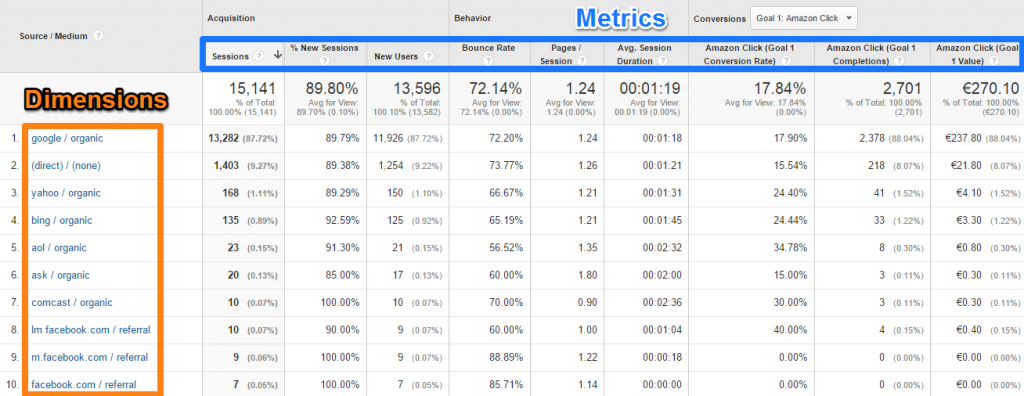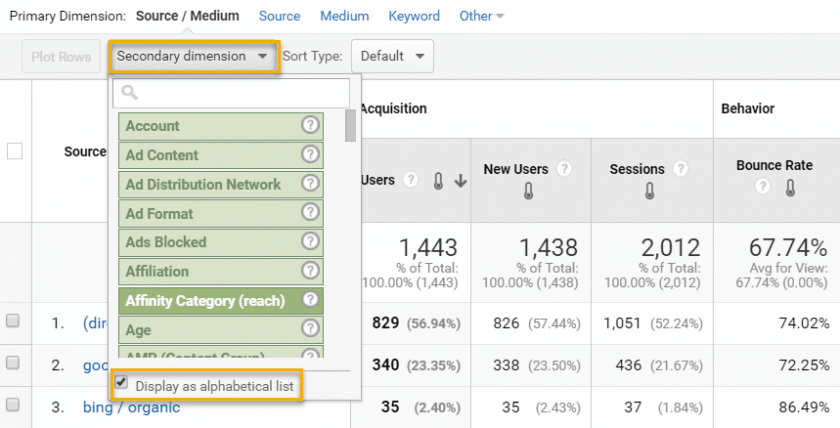Insights into the 'Secondary Dimension' in Google Analytics: A Detailed Explanation
Wiki Article
Navigating the Depths of Secondary Dimension in Google Analytics: A Detailed Expedition on Its Functionality
In the realm of digital analytics, the details of data analysis usually hold the key to opening beneficial insights. Within the extensive toolkit of Google Analytics lies an attribute that offers as a concealed treasure for those that look for a much deeper understanding of individual behavior and internet site performance. Secondary dimensions, though relatively straightforward at first glimpse, nurture a riches of untapped possible waiting to be taken advantage of. As we get started on this journey to check out the nuanced performance of secondary measurements, we will certainly uncover exactly how this attribute can illuminate patterns, reveal relationships, and inevitably pave the method for informed decision-making in the digital landscape.Understanding Secondary Dimensions in Google Analytics

Comprehending just how secondary dimensions work is crucial for leveraging the complete power of Google Analytics. These measurements aid you answer a lot more intricate inquiries concerning individual actions and the performance of your internet site content and marketing initiatives. As an example, you can use additional dimensions to examine which internet browsers or tools are most frequently made use of by visitors that purchase, or to compare the bounce prices of different web traffic resources. By combining main metrics with additional measurements, you can get valuable insights that drive informed decision-making and optimization approaches - what is a “secondary dimension” in google analytics?.
Leveraging Secondary Measurements for Information Analysis
Building upon the foundational understanding of how additional dimensions boost information evaluation in Google Analytics, the application of these added layers of details ends up being paramount in removing useful insights for informed decision-making and optimization strategies. By leveraging additional dimensions, experts can dig deeper right into the performance metrics by including even more context to the key dimensions, thus discovering concealed patterns and correlations that may not appear initially look. This deeper degree of evaluation allows organizations to better understand individual habits, identify fads, and identify areas for enhancement.
Additionally, second measurements supply an even more thorough view of the information, permitting division based upon numerous criteria such as demographics, devices, website traffic resources, and much more. This segmentation facilitates a much more granular analysis, making it possible for businesses to customize their techniques and campaigns to specific audience segments for enhanced targeting and personalization. In significance, the calculated use secondary dimensions equips organizations to make data-driven decisions that drive development and success in the digital landscape.
Advanced Techniques for Second Measurement Implementation
Discovering complex approaches to harness the complete potential of second dimensions in Google Analytics elevates the depth and class of information evaluation for critical decision-making. One advanced method for applying second measurements is imp source the usage of custom-made measurements. In addition, combining additional dimensions with innovative sectors can give even more granular understandings by using multiple layers of segmentation to the data.Interpreting Insights With Secondary Dimensions

When interpreting insights via secondary dimensions, it is necessary to consider the context of the data and exactly how various measurements communicate with each other. For instance, understanding which specific traffic sources lead to higher conversion rates or recognizing which tools individuals prefer for making purchases can supply actionable insights for maximizing advertising and marketing campaigns and boosting general website efficiency. By thoroughly checking out the information with secondary dimensions in mind, services can make educated choices that drive purposeful results and enhance their digital visibility.
Maximizing Efficiency With Second Measurements

One crucial means to enhance efficiency with additional dimensions is by segmenting data extra granularly. This allows you to isolate certain elements that may be influencing your metrics and acquire a better understanding of what drives success or failing in your digital efforts. By incorporating secondary measurements such as 'tool group' and 'landing page,' you can identify which tool kinds are most reliable for certain touchdown pages, enabling you to customize your strategies accordingly.
Moreover, utilizing secondary dimensions can help you determine fads, patterns, and connections that might not this be apparent when evaluating data with key measurements alone. This much deeper level of analysis can result in more educated decision-making and inevitably enhance the total performance of your website or digital marketing projects.
Verdict
To conclude, secondary dimensions in Google Analytics play a vital duty in enhancing information analysis and providing deeper insights right into internet site efficiency. By utilizing advanced methods and interpreting the information efficiently, companies can optimize their strategies and boost overall performance. Recognizing the capability of additional dimensions is vital for making informed choices and driving success in the digital landscape.By leveraging secondary measurements, analysts can delve much deeper into the performance metrics by including even more context to the key measurements, therefore uncovering hidden patterns and connections that might not be apparent at initial glance. One innovative strategy for carrying out second dimensions is the usage of customized measurements.Having actually grasped advanced strategies like personalized measurements and regex for additional dimension execution in Google Analytics, the next essential step is analyzing the beneficial insights derived via these advanced data division methods. Analyzing understandings through additional measurements entails examining the partnerships in between the key and second measurements selected, revealing patterns, fads, and connections that might not be instantly evident when looking at the data in its whole.When translating understandings through secondary dimensions, it is crucial to take into consideration the context of the data and how various measurements engage with each various other.
Report this wiki page